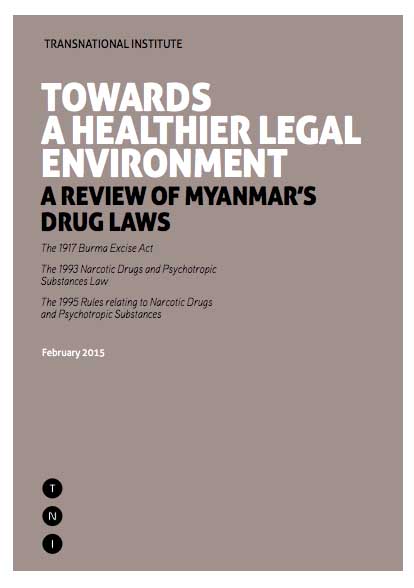Transnational Institute: Towards a Healthier Legal Environment – A Review of Myanmar’s Drug Laws
By Transnational Institute • February 16, 2015 This report reviews Myanmar’s drug laws and related policies, including the 1917 Burma Excise Act; the 1993 Narcotic Drugs and Psychotropic Substances Law; and the 1995 Rules relating to Narcotic Drugs and Psychotropic Substances. Since these laws were enacted several important changes have taken place inside and outside of Myanmar.
This report reviews Myanmar’s drug laws and related policies, including the 1917 Burma Excise Act; the 1993 Narcotic Drugs and Psychotropic Substances Law; and the 1995 Rules relating to Narcotic Drugs and Psychotropic Substances. Since these laws were enacted several important changes have taken place inside and outside of Myanmar.
The decision of the Myanmar Government to review the law is not only timely but also offers a prospect to improve the drugs legislation and to ensure that the laws address drug-related problems in the country more effectively. It is an opportunity to ensure that affected populations have access to health care and development, taking into account both national conditions and international developments and best practices.
This review paper will first give an overview of Myanmar’s current legal and policy framework related to drugs, followed by an overall analysis. After that it will make specific comments on a number of key articles. In addition, the review will outline some international obligations and best practices. Finally, the paper will make some overall conclusions and recommendations
Drug-Related Problems in Myanmar
Drug production and consumption trends have changed over the years and Myanmar faces several serious drug-related challenges. Myanmar is currently the second largest producer of raw opium in the world, after Afghanistan. After a period of initial decline, poppy cultivation in the country has tripled again since 2006.1 Most of the poppy is cultivated by impoverished ethnic minority communities in the country’s uplands, who grow opium as a cash crop to meet their basic needs, including food, medicines, clothing and access to education. Opium is also used as a painkiller and against diarrhea in areas where there is no access to essential medicines. Opium has traditional, cultural and religious use.
In short, for such communities, opium is a solution it helps to solve their main problems and allows them to live a life in dignity. Myanmar is also a major producer of heroin and amphetamine-type stimulants (ATS)2, and large quantities of these substances are smuggled to neighbouring countries. Precursors to make heroin and ATS are not produced in Myanmar; these originate mainly from neighboring India and China.
Myanmar has some serious drug use related problems. There are no reliable data available on number of drug users, drug consumption trends, drug use patterns, and drug use related health problems, as there has not been any national drug use survey. However, available evidence from case studies in selected areas suggests a significant number of injecting heroin users, with high concentrations in the northern part of the country (especially Kachin and Shan States).
Many of them have serious health problems related to their drug use, including HIV/AIDS and Hepatitis C. Injecting drug use has been one of the key drivers of the spread of HIV/ AIDS in Myanmar. There also is a large and growing number of ATS users in the country. In most areas where opium cultivation is present, traditional opium uses also take place, but these are less problematic. Since the current drug laws were promulgated, important developments have taken place. The most serious of these is the large number of injecting drug users that have been infected by HIV by sharing unclean needle syringes.
Drugs production and trafficking have fuelled conflict in Myanmar, which has experienced decades of civil war. It has stimulated corruption and contributed to lack of rule of law. The drug trade is a highly profitable business, and has attracted international criminal syndicates who have aligned themselves with conflict actors in Myanmar.
Tags: Transnational InstituteThis post is in: Drugs, Human Rights, Law
Related PostsChina’s Engagement in Myanmar: From Malacca Dilemma to Transition Dilemma
The right to land at crossroads in Myanmar
The Meaning of Land in Myanmar
No Women, No Peace: Gender Equality, Conflict and Peace in Myanmar
The 2015 General Election in Myanmar: What Now for Ethnic Politics?









 All posts
All posts